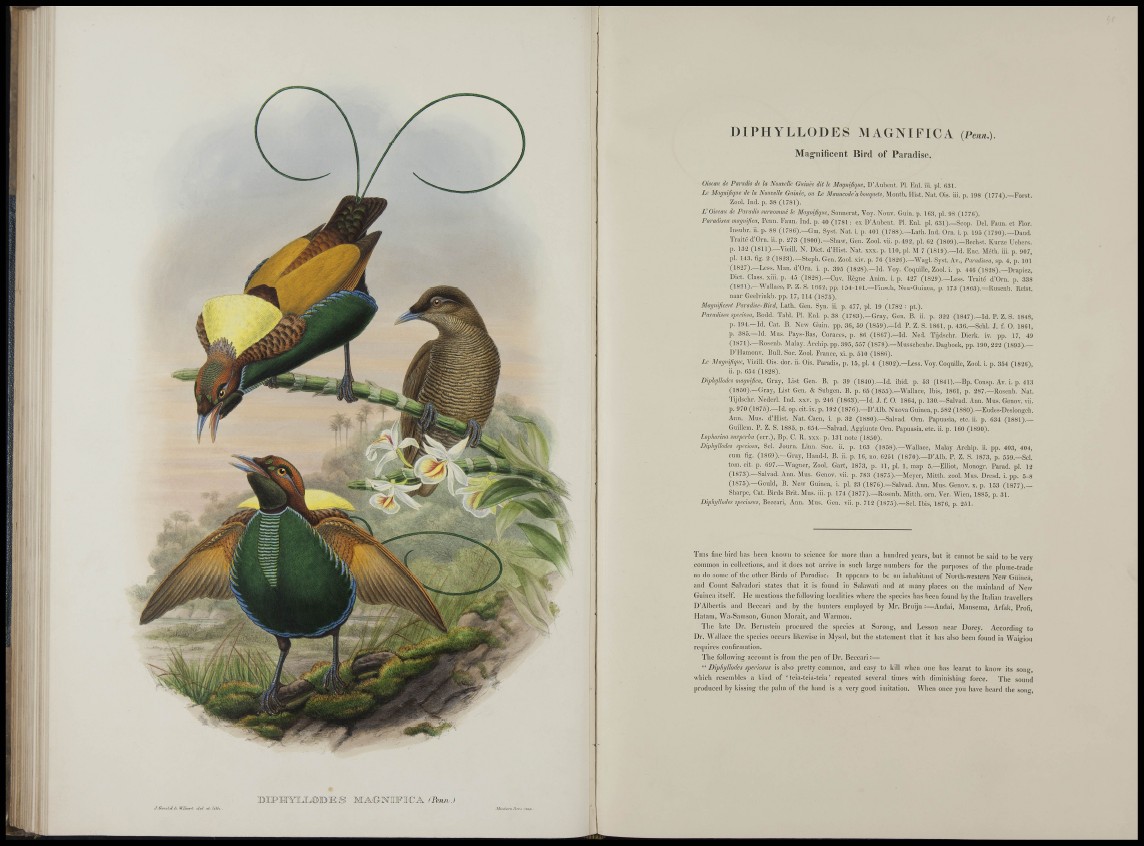
¡if;
:i ili
ri
1,1'Ì Ü ï!
B I I P E m L I L d ì B E S! M A G N I F I C A iPe>m .I
J.GoulU& XHeti-i iM Ot Mh
DIPHYLLODES MAGNIFICA (/w),
Mag-nificent Bird of Paradise.
Oiseau de Paradis de la Nouvelle Guinie dit le Magnifique, U'Aubeiit. PI. Eni. iii. p i (131.
Le Magnifique de la Nouvelle Guinie, mi, Le Manueodeahonqutts, Monti). Ilist. Nat. Oi.s. ili. p. 198 (1774).—Forst.
Zool. Ind. p. 38 (1781).
L'Oiseau de Paradis surnommé le Magnifique, Sonnerat, Voy. NÜUV. Guin. p. 1(Ì3, pl. 08 (177H).
Paradisea magnifica, Penn. Faun. Ind. p. 40 (1781 : ex D'Aubent. PI. Eni. pi. r.:il).-Scop. Del. Faun, et Fior.
Insubr. ii. p. 88 (1786).—Gtn. Syst. Nat. i. p. 401 (1788).—Lath. Ind. Orn. i. p. 195 (17!)()).—Daud.
Traité d'Orn. ii. p. 273 (1800).—Shaw, Gen. Zool. vii. p. 492, pi. Ö2 (180!)).—Beeilst. Kurze Ueber.s.
p. 132 (1811).—Vieill. N. Dict. d'Hist. Nat. xxx. p. 110, pi. M 7 (1819) .—Id. Ene. Méth. iii. p. 907,
pi. 143. fig. 2 (1823).—Steph. Gen. Zool. xiv. p. 7C (1826) .—Wagl Syst. Av., Paradisea, sp. 4, p. 101
(1827).—Less. Man. d'Orn. i. p. 395 (1828).—Id. Voy. Coquille, Zool. i. p. 44Ü (1828).—Drapiez,
Dict. Class, xiii. p. 45 (182S).—Cuv. Règne Anim. i. p. 427 (1829).—Less. Traité d'Orn. p. 338
(1831).—Wallace, P. Z. S. 1862, pp. 154-161.—Finscli, Neu-Guinea, p. 173 (1865).—Roseub. Reist,
naar Geelvinkb. pp. 17, 114 (1875).
Magnificent Paradise-Bird, Lath. Gen. Syn. ii. p, 477, pi. 19 (1782 : pt.).
Paradisea speciosa,'Qoàà. Tabi. PI. Eni. p. 38 (1783).—Gray, Gen. B. ii. p. 322 (1847).—Id. P. Z. S. 1848,
p. 194.—Id. Cat. B. New Guin. pp. 36, 59 (1859).—Id P. Z. S. 1861, p. 436.—Sehl J. f. 0 . 1861,
p. 385.—Id. Mus. Pays-Bas, Coraces, p. 86 (1867).—Id. Ned. Tijdsebr. Dierk. iv. pp. 17, 49
(1871).—Rosenb. Malay. Archip. pp. 395, 557 (1879).—Musschcnbr. Dagboek, pp. 190, 222 (1893).—
D'IIamonv. Bull Soc. Zool France, xi. p. 510 (1886).
Le Magnifique, Vieill Ois. dor. ii. Ois. Paradis, p. 15, pl. 4 (1802).—Less. Voy. Coquille, Zool i. p. 354 (1826),
ii. p. 654 (1828).
Diphjllodes magnifiiea, Gray, List Gen. B. p. 39 (1840).—Id. ibid. p. 53 (1841).—Bp. Consp. Av. i. p. 413
(1850).—Gray, List Gen. & Subgen. B. p. 65 (1855).—Wal lace, Ibis, 1861, p. 287.—Rosenb. Nat.
Tijdschr. Nederl. Ind. xxv. p. 246 (1863).—Id J. f, 0 . 1864, p. 130.—Salvad. Ann. Mus. Genov. vii.
p. 970 (1875).—Id. op. cit. ix. p. 192 (1876).—D'Alb. Nuova Guinea, p. 582 (1880).—Eudes-Deslongch.
Ann. Mus. d'IIist. Nat. Caen, i. p. 32 (1880).—Salvad, Orn. Papuasia, etc. ii. p. 634 (1881).—
Guillem, P. Z, S. 1885, p. 654.—Salvad. Aggiunte Orn. Papuasia, etc. ii. p. 160 (1890).
Lophorim surperha (crr.), Bp. C. R. xxx. p. 131 note (1850).
Diphjllodes speciosa. Sel Joui '11. Limi. boc. II. p. 163 ^1858).—^'^qHîicg, IVIiilfiy Arcliip. ii. pp- 403, 404
cum fig. (1869).—Gray, Hand-l B. ii. p. 16, no. 6251 (I 870) .—D'Alb. P. Z. S. 1873, p. 559.—Sel.
tom. cit. p. 697.—Wagner, Zool Gart, 1873, p. 11, pl. 1, map 5.—Elliot, Monogr. Parad. pl. 12
(1873).—Salvad. Ann. Mus. Genov. vii. p. 783 (1875).—Meyer, Mitth. zool. Mus. Dresd. i. pp. 5-8
(1875).—Gould, B. New Guinea, i. pl. 23 (1876).—Salvad. Ann. Mus. Genov. x. p. 153 (1877).—
Sharpe, Cat. Birds Brit. Mus. iii. p. 174 (1877).—Rosenb. Mitth. orn. Ver. Wien, 1885, p. 31.
Diphjllodes speciosus, Beccari, Ann. Mus. Gen. vii. p. 712 (1875).—Sel Ibis, 1876, p. 251.
THIS fine bird lias been knowii to science for more than ii hunflreil years, but it cannot be said to be very
common in collection.s, and it does not arrive in such large numbers for the purposes of the plume-trade
as do some of tlie other 13irds of Paradise. It appears to he an inhabitant of North-western Neiv Guinea,
aiul Count Salvador! states that it is found in Salawati and at many places on the mainland of New
Guinea itself. He mentions the following localities where the s|)ecies has been found hy the Italian travellers
D ' A l h e r t i s and Bcccari and hy tlie hunters employed by Mr. Brnijn :—Andai, Mansema, Arfak, Profi,
I l a t a n i , Wa-Samson, Gunon Morait, and AVarnion.
T l i e late Dr. Jieriisteiii procured the species at Sorong, and Lesson near Dorey. According to
D r . 'Wallace the species occurs likewise in Mysol, but the statement that it lias also been found In Waigioii
r e q u i r e s conlirination.
T h e following account is from the pen of Dr. Becearl:—
" Diphgllodes spcciosm is also pretty common, and easy to kill when one has learnt to know its song,
which resembles a kiiul of ' (ela-teia-teia' repeated several times with diminishing force. The sound
produced by kissing the palm of the hand is a very good imitation. M'lien once you have heard the song,